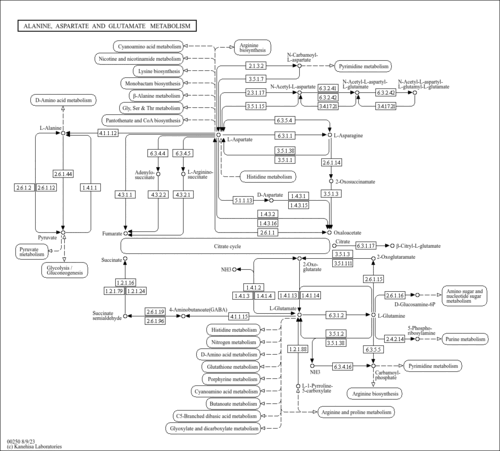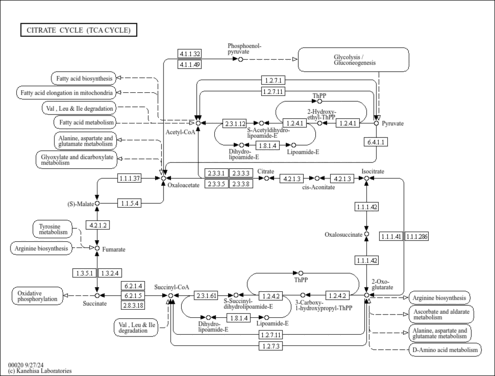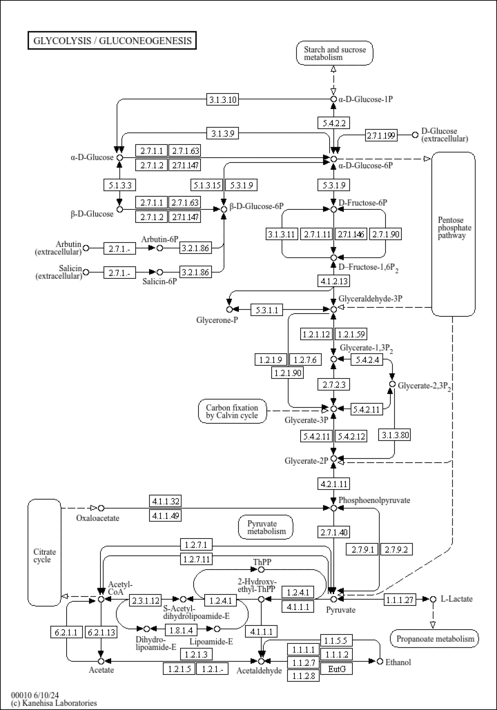| GC-MS Spectra| Spectrum Type | Description | Splash Key | Deposition Date | Source | View |
|---|
| Experimental GC-MS | GC-MS Spectrum - Oxalacetic acid GC-EI-TOF (Pegasus III TOF-MS system, Leco; GC 6890, Agilent Technologies) (Non-derivatized) | splash10-00dr-4900000000-9d943d40beaca3c602a1 | 2014-06-16 | HMDB team, MONA, MassBank | View Spectrum | | Experimental GC-MS | GC-MS Spectrum - Oxalacetic acid GC-MS (1 MEOX; 2 TMS) | splash10-007a-9210000000-020f60717e2ea79d1ccd | 2014-06-16 | HMDB team, MONA, MassBank | View Spectrum | | Experimental GC-MS | GC-MS Spectrum - Oxalacetic acid GC-MS (1 MEOX; 2 TMS) | splash10-000b-9540000000-a53f674cc98960834f88 | 2014-06-16 | HMDB team, MONA, MassBank | View Spectrum | | Experimental GC-MS | GC-MS Spectrum - Oxalacetic acid GC-MS (1 MEOX; 3 TMS) | splash10-001a-8940000000-40b790e06141d7180938 | 2014-06-16 | HMDB team, MONA, MassBank | View Spectrum | | Experimental GC-MS | GC-MS Spectrum - Oxalacetic acid GC-MS (Non-derivatized) | splash10-007a-9210000000-020f60717e2ea79d1ccd | 2017-09-12 | HMDB team, MONA, MassBank | View Spectrum | | Experimental GC-MS | GC-MS Spectrum - Oxalacetic acid GC-MS (Non-derivatized) | splash10-000b-9540000000-a53f674cc98960834f88 | 2017-09-12 | HMDB team, MONA, MassBank | View Spectrum | | Experimental GC-MS | GC-MS Spectrum - Oxalacetic acid GC-MS (Non-derivatized) | splash10-001a-8940000000-40b790e06141d7180938 | 2017-09-12 | HMDB team, MONA, MassBank | View Spectrum | | Experimental GC-MS | GC-MS Spectrum - Oxalacetic acid GC-EI-TOF (Non-derivatized) | splash10-0002-4930000000-7e995327b0b9c1af0914 | 2017-09-12 | HMDB team, MONA, MassBank | View Spectrum | | Predicted GC-MS | Predicted GC-MS Spectrum - Oxalacetic acid GC-MS (Non-derivatized) - 70eV, Positive | splash10-000f-9100000000-6718417e7196063f9544 | 2016-09-22 | Wishart Lab | View Spectrum | | Predicted GC-MS | Predicted GC-MS Spectrum - Oxalacetic acid GC-MS (2 TMS) - 70eV, Positive | splash10-00ds-9520000000-5a082ec8843f6fbc3b15 | 2017-10-06 | Wishart Lab | View Spectrum | | Predicted GC-MS | Predicted GC-MS Spectrum - Oxalacetic acid GC-MS (Non-derivatized) - 70eV, Positive | Not Available | 2021-10-12 | Wishart Lab | View Spectrum | | Predicted GC-MS | Predicted GC-MS Spectrum - Oxalacetic acid GC-MS (Non-derivatized) - 70eV, Positive | Not Available | 2021-10-12 | Wishart Lab | View Spectrum | | Predicted GC-MS | Predicted GC-MS Spectrum - Oxalacetic acid GC-MS (TMS_1_1) - 70eV, Positive | Not Available | 2021-11-05 | Wishart Lab | View Spectrum | | Predicted GC-MS | Predicted GC-MS Spectrum - Oxalacetic acid GC-MS (TMS_1_2) - 70eV, Positive | Not Available | 2021-11-05 | Wishart Lab | View Spectrum | | Predicted GC-MS | Predicted GC-MS Spectrum - Oxalacetic acid GC-MS (TMS_1_3) - 70eV, Positive | Not Available | 2021-11-05 | Wishart Lab | View Spectrum | | Predicted GC-MS | Predicted GC-MS Spectrum - Oxalacetic acid GC-MS (TMS_2_2) - 70eV, Positive | Not Available | 2021-11-05 | Wishart Lab | View Spectrum | | Predicted GC-MS | Predicted GC-MS Spectrum - Oxalacetic acid GC-MS (TMS_2_3) - 70eV, Positive | Not Available | 2021-11-05 | Wishart Lab | View Spectrum | | Predicted GC-MS | Predicted GC-MS Spectrum - Oxalacetic acid GC-MS (TBDMS_1_1) - 70eV, Positive | Not Available | 2021-11-05 | Wishart Lab | View Spectrum | | Predicted GC-MS | Predicted GC-MS Spectrum - Oxalacetic acid GC-MS (TBDMS_1_2) - 70eV, Positive | Not Available | 2021-11-05 | Wishart Lab | View Spectrum | | Predicted GC-MS | Predicted GC-MS Spectrum - Oxalacetic acid GC-MS (TBDMS_1_3) - 70eV, Positive | Not Available | 2021-11-05 | Wishart Lab | View Spectrum | | Predicted GC-MS | Predicted GC-MS Spectrum - Oxalacetic acid GC-MS (TBDMS_2_1) - 70eV, Positive | Not Available | 2021-11-05 | Wishart Lab | View Spectrum | | Predicted GC-MS | Predicted GC-MS Spectrum - Oxalacetic acid GC-MS (TBDMS_2_2) - 70eV, Positive | Not Available | 2021-11-05 | Wishart Lab | View Spectrum | | Predicted GC-MS | Predicted GC-MS Spectrum - Oxalacetic acid GC-MS (TBDMS_2_3) - 70eV, Positive | Not Available | 2021-11-05 | Wishart Lab | View Spectrum | | MS | Mass Spectrum (Electron Ionization) | splash10-0006-9000000000-f371299a07d43c23ff1d | 2015-03-01 | Not Available | View Spectrum |
MS/MS Spectra| Spectrum Type | Description | Splash Key | Deposition Date | Source | View |
|---|
| Experimental LC-MS/MS | LC-MS/MS Spectrum - Oxalacetic acid Quattro_QQQ 10V, Negative-QTOF (Annotated) | splash10-000i-9000000000-0be675f3aa3e973393b7 | 2012-07-24 | HMDB team, MONA | View Spectrum | | Experimental LC-MS/MS | LC-MS/MS Spectrum - Oxalacetic acid Quattro_QQQ 25V, Negative-QTOF (Annotated) | splash10-000f-9000000000-4fba97fcd7b0f2215f75 | 2012-07-24 | HMDB team, MONA | View Spectrum | | Experimental LC-MS/MS | LC-MS/MS Spectrum - Oxalacetic acid Quattro_QQQ 40V, Negative-QTOF (Annotated) | splash10-0006-9000000000-9b1f4171aee6283a3cbd | 2012-07-24 | HMDB team, MONA | View Spectrum | | Experimental LC-MS/MS | LC-MS/MS Spectrum - Oxalacetic acid , negative-QTOF | splash10-014i-0900000000-7c598fd9c78acb94dacd | 2017-09-14 | HMDB team, MONA | View Spectrum | | Experimental LC-MS/MS | LC-MS/MS Spectrum - Oxalacetic acid QTOF 3V, positive-QTOF | splash10-014i-4900000000-e7803730ae7986a1b9fb | 2020-07-22 | HMDB team, MONA | View Spectrum | | Experimental LC-MS/MS | LC-MS/MS Spectrum - Oxalacetic acid QTOF 4V, positive-QTOF | splash10-014r-5900000000-8e478338a7c0e65e62ba | 2020-07-22 | HMDB team, MONA | View Spectrum | | Experimental LC-MS/MS | LC-MS/MS Spectrum - Oxalacetic acid QTOF 5V, positive-QTOF | splash10-014r-7900000000-f681763317e1ae86e691 | 2020-07-22 | HMDB team, MONA | View Spectrum | | Experimental LC-MS/MS | LC-MS/MS Spectrum - Oxalacetic acid QTOF 7V, positive-QTOF | splash10-00kr-9600000000-aa8adf9a96041dddbbdd | 2020-07-22 | HMDB team, MONA | View Spectrum | | Experimental LC-MS/MS | LC-MS/MS Spectrum - Oxalacetic acid QTOF 10V, positive-QTOF | splash10-000i-9200000000-e62c47ca2bc492900178 | 2020-07-22 | HMDB team, MONA | View Spectrum | | Experimental LC-MS/MS | LC-MS/MS Spectrum - Oxalacetic acid QTOF 15V, positive-QTOF | splash10-000i-9000000000-5485ddd84a64ea0ca0b9 | 2020-07-22 | HMDB team, MONA | View Spectrum | | Experimental LC-MS/MS | LC-MS/MS Spectrum - Oxalacetic acid QTOF 17V, positive-QTOF | splash10-000i-9000000000-79521cb04a2b23e39c1e | 2020-07-22 | HMDB team, MONA | View Spectrum | | Experimental LC-MS/MS | LC-MS/MS Spectrum - Oxalacetic acid QTOF 20V, positive-QTOF | splash10-000m-9000000000-601c8d2ec63f8b01a61e | 2020-07-22 | HMDB team, MONA | View Spectrum | | Experimental LC-MS/MS | LC-MS/MS Spectrum - Oxalacetic acid QTOF 23V, positive-QTOF | splash10-000e-9000000000-13d369c58d8930958d92 | 2020-07-22 | HMDB team, MONA | View Spectrum | | Experimental LC-MS/MS | LC-MS/MS Spectrum - Oxalacetic acid QTOF 25V, positive-QTOF | splash10-0005-9000000000-df8387ef907fb71342eb | 2020-07-22 | HMDB team, MONA | View Spectrum | | Experimental LC-MS/MS | LC-MS/MS Spectrum - Oxalacetic acid QTOF 27V, positive-QTOF | splash10-0005-9000000000-908644b5d7041346f582 | 2020-07-22 | HMDB team, MONA | View Spectrum | | Experimental LC-MS/MS | LC-MS/MS Spectrum - Oxalacetic acid QTOF 30V, positive-QTOF | splash10-0005-9000000000-ecca787a800164d0296f | 2020-07-22 | HMDB team, MONA | View Spectrum | | Experimental LC-MS/MS | LC-MS/MS Spectrum - Oxalacetic acid QTOF 33V, positive-QTOF | splash10-0005-9000000000-180a7c51b1f93cb8fff2 | 2020-07-22 | HMDB team, MONA | View Spectrum | | Experimental LC-MS/MS | LC-MS/MS Spectrum - Oxalacetic acid QTOF 35V, positive-QTOF | splash10-0005-9000000000-709c49f609f5a711a288 | 2020-07-22 | HMDB team, MONA | View Spectrum | | Experimental LC-MS/MS | LC-MS/MS Spectrum - Oxalacetic acid QTOF 40V, positive-QTOF | splash10-0005-9000000000-aa103ab9beb03bd6eb22 | 2020-07-22 | HMDB team, MONA | View Spectrum | | Predicted LC-MS/MS | Predicted LC-MS/MS Spectrum - Oxalacetic acid 10V, Positive-QTOF | splash10-014i-3900000000-6f4e965a3f513bf8db13 | 2015-04-24 | Wishart Lab | View Spectrum | | Predicted LC-MS/MS | Predicted LC-MS/MS Spectrum - Oxalacetic acid 20V, Positive-QTOF | splash10-014i-9600000000-8ae7abf60057088e14db | 2015-04-24 | Wishart Lab | View Spectrum | | Predicted LC-MS/MS | Predicted LC-MS/MS Spectrum - Oxalacetic acid 40V, Positive-QTOF | splash10-01bc-9100000000-5724c215c46a4f568140 | 2015-04-24 | Wishart Lab | View Spectrum | | Predicted LC-MS/MS | Predicted LC-MS/MS Spectrum - Oxalacetic acid 10V, Negative-QTOF | splash10-0019-8900000000-829898d0849b1fbf1c28 | 2015-04-25 | Wishart Lab | View Spectrum | | Predicted LC-MS/MS | Predicted LC-MS/MS Spectrum - Oxalacetic acid 20V, Negative-QTOF | splash10-000i-9100000000-5a5ff8fb7cb52eebf0c8 | 2015-04-25 | Wishart Lab | View Spectrum | | Predicted LC-MS/MS | Predicted LC-MS/MS Spectrum - Oxalacetic acid 40V, Negative-QTOF | splash10-0006-9000000000-657d1384d478ddc33b6d | 2015-04-25 | Wishart Lab | View Spectrum |
NMR Spectra| Spectrum Type | Description | Deposition Date | Source | View |
|---|
| Experimental 1D NMR | 1H NMR Spectrum (1D, 500 MHz, H2O, experimental) | 2012-12-04 | Wishart Lab | View Spectrum | | Predicted 1D NMR | 1H NMR Spectrum (1D, 100 MHz, D2O, predicted) | 2021-09-29 | Wishart Lab | View Spectrum | | Predicted 1D NMR | 13C NMR Spectrum (1D, 100 MHz, D2O, predicted) | 2021-09-29 | Wishart Lab | View Spectrum | | Predicted 1D NMR | 1H NMR Spectrum (1D, 1000 MHz, D2O, predicted) | 2021-09-29 | Wishart Lab | View Spectrum | | Predicted 1D NMR | 13C NMR Spectrum (1D, 1000 MHz, D2O, predicted) | 2021-09-29 | Wishart Lab | View Spectrum | | Predicted 1D NMR | 1H NMR Spectrum (1D, 200 MHz, D2O, predicted) | 2021-09-29 | Wishart Lab | View Spectrum | | Predicted 1D NMR | 13C NMR Spectrum (1D, 200 MHz, D2O, predicted) | 2021-09-29 | Wishart Lab | View Spectrum | | Predicted 1D NMR | 1H NMR Spectrum (1D, 300 MHz, D2O, predicted) | 2021-09-29 | Wishart Lab | View Spectrum | | Predicted 1D NMR | 13C NMR Spectrum (1D, 300 MHz, D2O, predicted) | 2021-09-29 | Wishart Lab | View Spectrum | | Predicted 1D NMR | 1H NMR Spectrum (1D, 400 MHz, D2O, predicted) | 2021-09-29 | Wishart Lab | View Spectrum | | Predicted 1D NMR | 13C NMR Spectrum (1D, 400 MHz, D2O, predicted) | 2021-09-29 | Wishart Lab | View Spectrum | | Predicted 1D NMR | 1H NMR Spectrum (1D, 500 MHz, D2O, predicted) | 2021-09-29 | Wishart Lab | View Spectrum | | Predicted 1D NMR | 13C NMR Spectrum (1D, 500 MHz, D2O, predicted) | 2021-09-29 | Wishart Lab | View Spectrum | | Predicted 1D NMR | 1H NMR Spectrum (1D, 600 MHz, D2O, predicted) | 2021-09-29 | Wishart Lab | View Spectrum | | Predicted 1D NMR | 13C NMR Spectrum (1D, 600 MHz, D2O, predicted) | 2021-09-29 | Wishart Lab | View Spectrum | | Predicted 1D NMR | 1H NMR Spectrum (1D, 700 MHz, D2O, predicted) | 2021-09-29 | Wishart Lab | View Spectrum | | Predicted 1D NMR | 13C NMR Spectrum (1D, 700 MHz, D2O, predicted) | 2021-09-29 | Wishart Lab | View Spectrum | | Predicted 1D NMR | 1H NMR Spectrum (1D, 800 MHz, D2O, predicted) | 2021-09-29 | Wishart Lab | View Spectrum | | Predicted 1D NMR | 13C NMR Spectrum (1D, 800 MHz, D2O, predicted) | 2021-09-29 | Wishart Lab | View Spectrum | | Predicted 1D NMR | 1H NMR Spectrum (1D, 900 MHz, D2O, predicted) | 2021-09-29 | Wishart Lab | View Spectrum | | Predicted 1D NMR | 13C NMR Spectrum (1D, 900 MHz, D2O, predicted) | 2021-09-29 | Wishart Lab | View Spectrum | | Experimental 2D NMR | [1H, 13C]-HSQC NMR Spectrum (2D, 600 MHz, H2O, experimental) | 2012-12-05 | Wishart Lab | View Spectrum | | Experimental 2D NMR | [1H, 13C] NMR Spectrum (2D, 800 MHz, experimental) | 2019-09-11 | Wishart Lab | View Spectrum |
IR Spectra| Spectrum Type | Description | Deposition Date | Source | View |
|---|
| Predicted IR Spectrum | IR Ion Spectrum (Predicted IRIS Spectrum, Adduct: [M-H]-) | 2023-02-03 | FELIX lab | View Spectrum | | Predicted IR Spectrum | IR Ion Spectrum (Predicted IRIS Spectrum, Adduct: [M+H]+) | 2023-02-03 | FELIX lab | View Spectrum | | Predicted IR Spectrum | IR Ion Spectrum (Predicted IRIS Spectrum, Adduct: [M+Na]+) | 2023-02-03 | FELIX lab | View Spectrum |
| Show more...
|---|
| General References | - Sweatman BC, Farrant RD, Holmes E, Ghauri FY, Nicholson JK, Lindon JC: 600 MHz 1H-NMR spectroscopy of human cerebrospinal fluid: effects of sample manipulation and assignment of resonances. J Pharm Biomed Anal. 1993 Aug;11(8):651-64. [PubMed:8257730 ]
- Zupke C, Sinskey AJ, Stephanopoulos G: Intracellular flux analysis applied to the effect of dissolved oxygen on hybridomas. Appl Microbiol Biotechnol. 1995 Dec;44(1-2):27-36. [PubMed:8579834 ]
- Efimov AS, Gulyi MF, Shcherbak AV, Dzvonkevich ND: [Levels of Krebs cycle metabolites in the blood and urine of patients with diabetes mellitus]. Probl Endokrinol (Mosk). 1983 Mar-Apr;29(2):10-4. [PubMed:6856592 ]
- el-Sharabasy MM: Observations on calcium oxalate stone formers. Br J Urol. 1992 Nov;70(5):474-7. [PubMed:1361403 ]
- Dworzak E, Grunicke H, Berger H, Jarosch E, Haas H, Hopfel I: [Pyruvate dehydrogenase deficiency in a child with persistent lactic acidosis]. J Clin Chem Clin Biochem. 1985 Jun;23(6):323-9. [PubMed:3926941 ]
- Koike K, Koike M: Fluorescent analysis of alpha-keto acids in serum and urine by high-performance liquid chromatography. Anal Biochem. 1984 Sep;141(2):481-7. [PubMed:6437276 ]
- Esenmo E, Chandramouli V, Schumann WC, Kumaran K, Wahren J, Landau BR: Use of 14CO2 in estimating rates of hepatic gluconeogenesis. Am J Physiol. 1992 Jul;263(1 Pt 1):E36-41. [PubMed:1322046 ]
- Petrarulo M, Facchini P, Cerelli E, Marangella M, Linari F: Citrate in urine determined with a new citrate lyase method. Clin Chem. 1995 Oct;41(10):1518-21. [PubMed:7586527 ]
- Sperl W, Maurer H, Dworschak E, Hopfel I, Hammerer I: [Lactic acid acidosis with mitochondrial myopathy due to a pyruvate dehydrogenase deficiency]. Padiatr Padol. 1985;20(1):55-67. [PubMed:3919358 ]
- Olubuyide IO, Festing MF, Chapman C, Higginson J, Whicher JT: Discriminant analysis of biochemical parameters in liver disease. Trop Gastroenterol. 1997 Jan-Mar;18(1):15-9. [PubMed:9197166 ]
- Rabinovich PD, Miliushkin PV: [Content of biological oxidation metabolites in the blood and urine of peptic ulcer patients]. Vopr Med Khim. 1979 Nov-Dec;25(6):755-8. [PubMed:516538 ]
- Schauenstein E, Kronberger L, Schaur RJ, Fink E, Georgiopulos E: [Malate and oxaloacetate levels in whole blood of patients with and without malignant tumor diseases]. Wien Klin Wochenschr. 1973 Jun 29;85(26):478-82. [PubMed:4717666 ]
- Allen RH, Stabler SP, Savage DG, Lindenbaum J: Elevation of 2-methylcitric acid I and II levels in serum, urine, and cerebrospinal fluid of patients with cobalamin deficiency. Metabolism. 1993 Aug;42(8):978-88. [PubMed:8345822 ]
- Wong LT, Davidson AG, Applegarth DA, Dimmick JE, Norman MG, Toone JR, Pirie G, Wong J: Biochemical and histologic pathology in an infant with cross-reacting material (negative) pyruvate carboxylase deficiency. Pediatr Res. 1986 Mar;20(3):274-9. [PubMed:3085060 ]
- Wilkins HM, Harris JL, Carl SM, E L, Lu J, Eva Selfridge J, Roy N, Hutfles L, Koppel S, Morris J, Burns JM, Michaelis ML, Michaelis EK, Brooks WM, Swerdlow RH: Oxaloacetate activates brain mitochondrial biogenesis, enhances the insulin pathway, reduces inflammation and stimulates neurogenesis. Hum Mol Genet. 2014 Dec 15;23(24):6528-41. doi: 10.1093/hmg/ddu371. Epub 2014 Jul 15. [PubMed:25027327 ]
| Show more...
|---|


